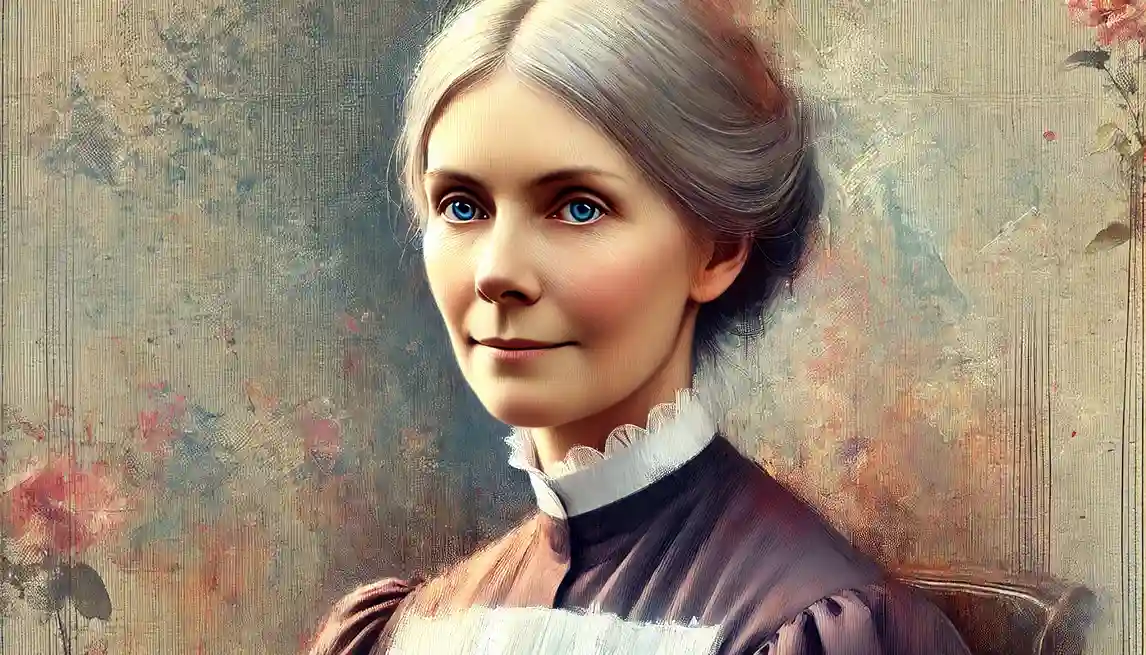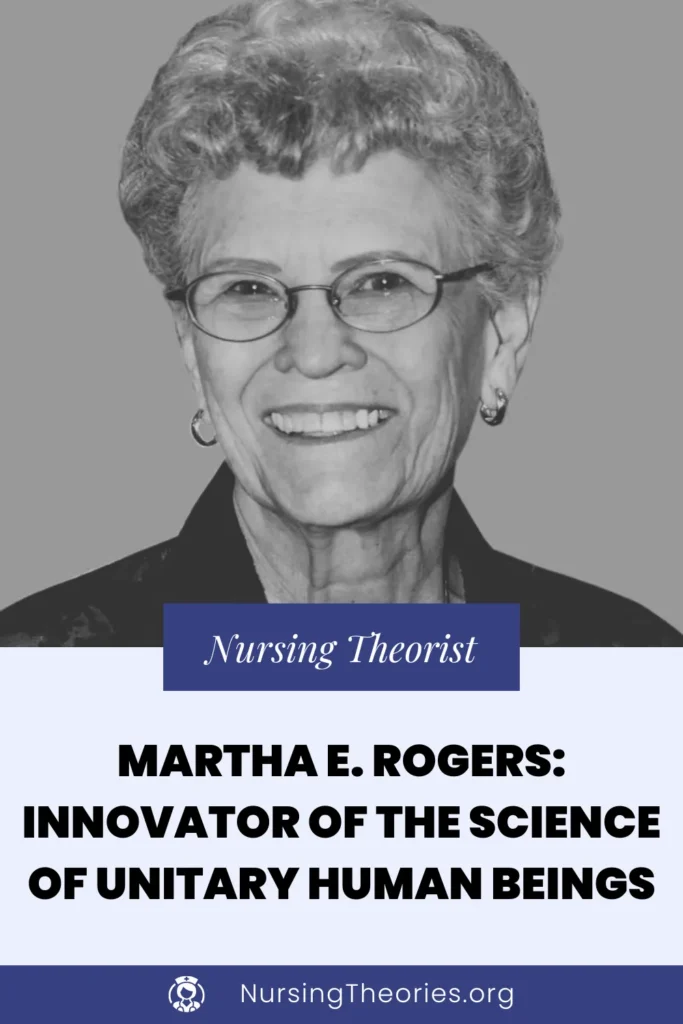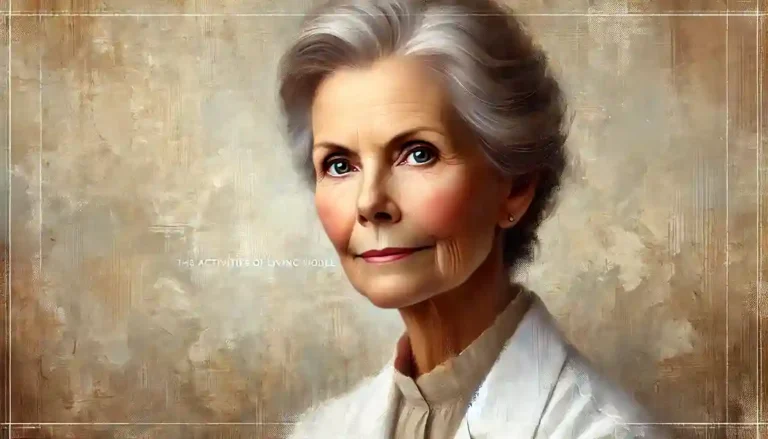Martha Elizabeth Rogers, a pioneering nurse theorist and educator, is best known for developing the Science of Unitary Human Beings, a revolutionary theory that views patients as integral parts of an interconnected and dynamic energy field.
Her innovative approach to nursing focuses on promoting harmony between humans and their environment, emphasizing holistic healing and well-being.
Rogers’ work reshaped nursing theory by introducing a broader, more inclusive perspective on health and care.
In this article, we cover Martha Rogers’ life, achievements, philosophy, and lasting impact on modern nursing.

Quick Summary
- Developed the Science of Unitary Human Beings, which focuses on humans as complex, dynamic energy fields.
- Emphasized holistic, non-invasive approaches to nursing that consider the patient’s entire environment.
- Advocated for the integration of science, art, and philosophy in nursing practice.
- Authored influential works that continue to guide nursing theory and practice globally.
- Recognized internationally for her contributions to theoretical advancements and holistic care.
Early Life and Background of Martha Rogers

Birth and Family Background of Martha Rogers
- Martha E. Rogers was born on May 12, 1914, in Dallas, Texas, into a family that encouraged intellectual curiosity and exploration.
- Her early exposure to science and the arts shaped her interdisciplinary approach to nursing.
Education and Early Influences in Rogers’ Life
- Rogers earned her nursing diploma from Knoxville General Hospital School of Nursing in 1936.
- She pursued higher education, earning a bachelor’s degree from George Peabody College, a master’s degree in public health from Johns Hopkins University, and a doctorate in nursing education from Teachers College, Columbia University.
- Her diverse academic background provided the foundation for her innovative theory.
Martha Rogers’ Philosophy and Vision for Nursing
- Rogers believed that nursing should move beyond treating physical symptoms to address the dynamic interactions between individuals and their environments.
- Her vision emphasized that nurses should focus on promoting harmony and balance in patients’ energy fields.
- Famous quote: “Nursing is a science and an art. It focuses on people as irreducible energy fields, constantly interacting with their environment.”
Martha Rogers’ Education and Early Nursing Career
Formal Education and Nursing Training of Martha Rogers
- Rogers’ advanced studies in public health, education, and nursing enabled her to develop a theory that bridges multiple disciplines.
- Her interdisciplinary background allowed her to explore the complex nature of human health and well-being.
Early Professional Experiences in Rogers’ Career
- Rogers began her career as a public health nurse, working in rural and underserved communities.
- Her experiences in community health highlighted the importance of addressing environmental factors in patient care, inspiring her to develop a holistic approach.
Key Achievements and Contributions of Martha Elizabeth Rogers
Development of the Science of Unitary Human Beings
- Rogers’ theory views humans as unitary beings, characterized by continuous energy exchanges with their environment. Key principles include:
- Energy Fields: The human and environmental fields are constantly interacting and influencing each other.
- Pattern and Organization: Health is determined by the patterns and rhythms of energy flow.
- Openness: Humans are open systems, continuously exchanging energy with their surroundings.
- Pandimensionality: Time, space, and energy interact in a nonlinear manner, influencing health outcomes.
- Her theory guides nurses in promoting holistic healing by considering the entire human experience.
Contributions to Nursing Education and Curriculum Development
- Rogers integrated her theory into nursing curricula, teaching students to approach care from a holistic, patient-centered perspective.
- She emphasized critical thinking and creativity in nursing practice, encouraging students to go beyond traditional medical models.
Research and Theoretical Advancements
- Rogers conducted extensive research on energy fields and their impact on health, bridging the gap between science and holistic care.
- Her work provided a scientific foundation for complementary and alternative therapies, such as therapeutic touch and energy healing.
Global Impact and Recognition
- Rogers’ theory has been adopted in nursing education and practice worldwide, influencing holistic and integrative care approaches.
- She received numerous awards and honors, including recognition as a trailblazer in nursing theory.
Overview of Martha Rogers’ Science of Unitary Human Beings
- The theory focuses on promoting harmony between individuals and their environment by addressing their physical, emotional, and spiritual dimensions.
- It guides nurses in creating healing environments that foster balance and well-being.
- To explore this theory in greater depth, visit the in-depth article on the Science of Unitary Human Beings.
Notable Publications by Martha Rogers
- An Introduction to the Theoretical Basis of Nursing – A seminal work that outlines her theory and its applications in nursing practice.
- Nursing Science and the Space Age – A publication exploring the evolving role of nursing in the context of technological and scientific advancements.
- Numerous journal articles on holistic care, energy fields, and unitary human beings.
Challenges and Criticisms of Martha Rogers’ Work
Challenges in Implementing the Theory in Traditional Settings
- Some healthcare providers have found it challenging to apply Rogers’ theory in conventional, task-oriented environments.
- Rogers encouraged flexibility and innovation in adapting the theory to different healthcare contexts.
Criticisms of the Abstract Nature of the Theory
- Critics argue that the theory’s abstract concepts, such as energy fields and pandimensionality, can be difficult to measure and apply in clinical practice.
- However, proponents highlight its success in guiding holistic care and improving patient outcomes.
Timeline of Major Milestones in Martha Rogers’ Life
- 1914: Born in Dallas, Texas.
- 1936: Earned her nursing diploma.
- 1954: Completed her doctorate in nursing education.
- 1970: Published An Introduction to the Theoretical Basis of Nursing.
- 1990s: Theory adopted globally in nursing curricula and holistic care practices.
- 1994: Passed away, leaving a lasting legacy in nursing theory.
Legacy and Lasting Impact of Martha Elizabeth Rogers
Impact on Nursing Practice and Patient Care
- Rogers’ theory has transformed nursing practice by promoting holistic and integrative approaches to health and healing.
Global Influence and Recognitions
- Her work is taught in nursing schools worldwide and applied in diverse healthcare settings.
- Rogers’ contributions have earned her international recognition as a leader in holistic nursing.
Final Years and Passing of Martha Rogers
- Rogers continued to refine her theory and mentor students until her passing in 1994.
- Her legacy lives on through the widespread application of her theory in nursing practice and education.
Key Lessons from Martha Rogers for Modern Nursing
- Holistic care: Addressing patients’ physical, emotional, and spiritual needs leads to better outcomes.
- Energy-based healing: Recognizing the role of energy fields can enhance patient care.
- Patient-centered environments: Creating healing spaces promotes balance and well-being.
- Interdisciplinary approaches: Integrating science, art, and philosophy enriches nursing practice.
- Lifelong learning: Nurses should continuously seek knowledge to improve holistic care practices.
Conclusion
Martha Elizabeth Rogers’ Science of Unitary Human Beings revolutionized nursing by introducing a holistic, energy-based framework that promotes harmony and balance.
Her work, explored further in the in-depth article on the Science of Unitary Human Beings, continues to inspire nurses globally.
Rogers’ legacy endures as her theory remains central to holistic, patient-centered care in modern nursing.



